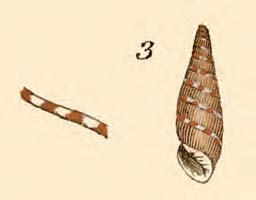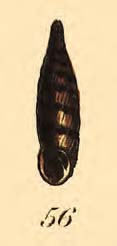|
I was delighted to learn that live examples of Papillifera papillaris had been discovered at Cliveden House (Ridout Sharpe, 2007). I was also a little saddened by the news. Cliveden House is on the Buckinghamshire side of the River Thames. Maidenhead, situated on the opposite side of the river, in Berkshire, is the town where I was born and where, in 1950, I first took up the study of British nonmarine molluscs. Many years ago, while still a Maidenhead resident, I visited Cliveden House. I regret that I did not look for snails during that visit, the more so as I always associate that property with the name of Lord Astor, for whom my father once worked, as a painter and decorator. Thus I missed the opportunity to go down in history as the first finder of an exotic addition to the British fauna, a distinctive snail living a stone’s throw from where I lived. Instead, I must content myself with penning a short note suggesting that Cliveden House may not have been its first British landfall. A hand-coloured engraving of what appears to be this species occurs in A descriptive catalogue of the British Testacea by William George Maton and Thomas Rackett (1807, pl. 5, fig. 3). An enlarged view of the crenulated suture of the species supports the identification. The associated text (pp 178-79), under the specific name Turbo bidens Linnaeus, says ‘Noticed as English by Dr. Pulteney’ and highlights the distinctive character of the suture. The engraving illustrates a specimen once owned by Richard Pulteney (1730-1801) whose collection was then housed in the Linnean Society of London. Maton and Rackett refer to a rare publication by Pulteney, who described the shell as having ‘the sutures prettily crenated’ (Pulteney, 1799: 46). Pulteney, they say, ‘notes it as a Dorsetshire shell; but there is reason to believe he was deceived, and that the species is not of British growth, since, notwithstanding a most diligent search, we have been unable to procure it.’ In 1807, too, William Turton published a brief description of Turbo bidens, based on the Pulteney shell (Turton, 1807: 186). A dozen years later he published a more detailed description of Turbo bidens, also based on the Pulteney shell (Turton, 1819: 224). Later still, in his wellknown Manual, he added an illustration to his description of the species he now called Clausilia bidens, giving the name Clausilia papillaris as a synonym (Turton, 1831: 73- 74, fig. 56). Once again his description is based on the Pulteney shell; the accompanying, hand-coloured figure is a passable representation of P. papillaris. In 1840 John Edward Gray brought out a much-revised edition of Turton’s Manual in which he added the following information about the supposed occurrence of the species in Scotland. ‘Mr. Forbes furnished Mr. Alder with the following account of the introduction of this species into the Fauna. He says, “I have lately obtained a manuscript copy of Laskey’s North British Testacea, written by himself, which fully explains the history of the British Clausilia papillaris. He states, that it was found by him in Granton Park, near Edinburgh, and that it was imported from abroad, in moss around the roots of some exotics.”’ (Turton, Ed. Gray, 1840: 15). The article referred to was ‘An account of North British Testacea’, by James Laskey (1811). What appears to be the ‘manuscript copy’ seen by Edward Forbes is preserved in the library of the Natural History Museum in London. It is actually a copy of the published article, with manuscript additions by Laskey. Turbo bidens does not occur in the printed article, but is the subject of an additional manuscript note, transcribed herewith: ‘This Shell was found in the Cabinet of the late Dr. Poultenay [sic] in poss[essio]n of the Lin. Soc. and was considered as a very doubtful Shell in Brit. Collection In 1826 I was fortunate in discovering this Shell in a plantation of Sir Alex[ande]r Hope at Lufness near Aberlady Scotland but with all my diligence for that year & 1827 & 1828 I found only 8 Specim[en]s alive, and 3 dead Tho[ugh] I offered a premium of 1s/ each only 2 was obtained. I am of Opinion still that [they] are of foreign growth and was imported here in Moss &c that was around the roots of plants that was brought from France and other parts - J Laskey.’ The locality given here differs from that published by Gray and there is no obvious explanation for this, unless Forbes saw another manuscript version of the note. Fred Woodward, who has long been interested in the life and work of James Laskey, kindly supplied me with a copy of the annotated Laskey article, in disk form, and pin-pointed the two localities. He told me that Granton Park lies on the coast to the west of Edinburgh and was once a stone quarry, while Lufness near Aberlady, lies on the coast to the east of Edinburgh. A plantation would seem to be a more likely place than a quarry to find specimens of a snail imported, with plants, from another country, but at this distance of time it hardly matters. It is enough to know that P. papillaris may have been found many years ago on the outskirts of Edinburgh. So what are we to make of these records? The Pulteney collection, presumably including the supposed P. papillaris, was auctioned in London in November 1863 (Chalmers- Hunt, 1976: 102). In any event, the specimen is no longer among the Linnean Society’s collections. Similarly no specimens are available to authenticate Laskey’s Scottish discovery. Pulteney’s record was dismissed as ‘spurious’ by Forbes and Hanley (1852: 124). Perhaps Laskey’s should be considered ‘spurious’ too. Nevertheless, this distinctive species does turn up in unexpected places occasionally. We may never know if Cliveden House was its first staging post in Britain, but climate change may help to ensure that it will not be its last. ReferencesChalmers-Hunt, J. M. Natural history auctions 1700-1972, &c. London. Laskey, J. 1811. Account of North British Testacea. Memoirs of the Wernerian Society 1: 370-417, 1 pl. [Laskey’s annotated copy is paginated 1-49.] Maton, W. G. & Rackett, T. 1807. A descriptive catalogue of the British Testacea. Transactions of the Linnean Society of London 8: 17-250, 5 pls. Menez, A. 2007. Papillifera papillaris (Müller, 1774) in Gibraltar. Mollusc World 13: 6-7. Pulteney, R. 1799. Catalogues of the birds, shells, and some of the more rare plants of Dorsetshire.From the new ... edition of Hutchins’s History of that county. London. Ridout Sharpe, J. 2007. Papillifera papillaris (Müller, 1774) in Britain: a giant leap for a small snail. Mollusc World 14: 12-14. Turton, W. 1807. British fauna, containing a compendium of the zoology of the British Islands, &c. Vol. 1 [all published]. Swansea. Turton, W. 1819. A conchological dictionary of the British Islands. Illust. col. or plain. London. Turton, W. 1831. A manual of the land and fresh-water shells of the British Islands, &c. Illust. col. (10 unnumbered pls). London. Turton, W. (Ed. J. E. Gray) 1840. A manual of the land and fresh-water shells of the British Islands, &c. Illust. col. (12 numbered pls). London. |
2. Hand-coloured engraving, supposedly illustrating Clausilia bidens Linnaeus (actually Papillifera papillaris), from Turton’s Manual, 1831, fig. 56. |
Early British records of Papillifera papillaris (Müller, 1774)
Issue
16
Page
20
Species

 1. Hand-coloured engravings, supposedly illustrating Turbo bidens Linnaeus (actually Papillifera papillaris) and its suture, from Maton and Rackett’s Descriptive Catalogue, 1807, pl. 5, fig. 3.
1. Hand-coloured engravings, supposedly illustrating Turbo bidens Linnaeus (actually Papillifera papillaris) and its suture, from Maton and Rackett’s Descriptive Catalogue, 1807, pl. 5, fig. 3.